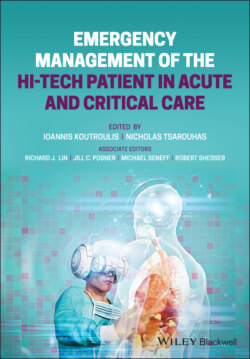Читать книгу Emergency Management of the Hi-Tech Patient in Acute and Critical Care - Группа авторов - Страница 27
Complications/Emergencies Tube Dislodgment
ОглавлениеTube dislodgment is a common emergency department chief complaint in both adults and children. This can occur because of coughing, gagging, pulling on the tubing, or getting the tubing caught around an object. In all cases, stop the feeding and inquire how long the patient can maintain his or her blood sugar without feeding. Hypoglycemia is a common complication for patients who are accustomed to receiving continuous feeds, and an infusion of dextrose‐containing IV fluids is commonly needed while awaiting feeding tube replacement. Replacement follows an algorithm based on the type of enteric feeding device and the duration since its initial placement (Figure 1.2). Unfortunately, tube replacement is not without risk, and the astute provider must be aware of clinical signs of an improperly positioned tube and how to best verify tube placement.
NG tube replacement is a simple procedure, and some patients may even replace their own NG tubes nightly; however, it is not without risk. Complication rates range from 1 to 2% in adults and up to 20–40% in pediatric patients, with higher rates seen in neonatal patients. Complications with improper NG tube placement include pneumonia if the tube is placed in the lungs and peritonitis if the tube perforates the bowel. Given this high complication rate, all NG tube replacements in the emergency department setting should be confirmed with a radiograph. Auscultation, enzyme testing, and pH testing are unreliable.
G‐tube placement is an equally common emergency department procedure, and complication rates range from 0.6 to 20%, with higher rates seen in immature tubes and tubes with traumatic dislodgement. The definition of an immature tube is debated in the literature. Most studies define immature tubes as those less than four to six weeks from placement; however, some studies define immature tubes as those less than six months from placement. There is an inverse relationship between the age of the tube, and, therefore, G‐tube tract healing, and the complication rate. In addition, patients who are symptomatic postreplacement are more likely to have a G‐tube complication. Complications include gastric outlet obstruction and intraperitoneal tube placement.
All G‐tube replacements can be completed at the bedside; however, the person performing the procedure and the method of checking placement are dependent on the age of the tube and the patient's presenting symptoms. The first tube change postoperatively is the most critical and should be completed by the subspecialty service responsible for the tube's placement. In addition, any stoma site with significant trauma or stoma that is difficult to identify should be evaluated by general surgery. Uncomplicated mature G‐tubes can be replaced at the bedside by the emergency department team, and placement should be confirmed with gastric aspirate and pH testing alone. For patients with immature tracts, trauma to the stoma site, or symptoms following G‐tube replacement, contrast‐enhanced radiograph is needed to confirm G‐tube placement prior to use. Extravasation of contrast dye on imaging and failure to fill the stomach indicates that the tube is improperly positioned.
Figure 1.2 Algorithm of the displaced enteric feeding device.
All transgastric jejunal tubes must be replaced by interventional radiology under fluoroscopic guidance.
